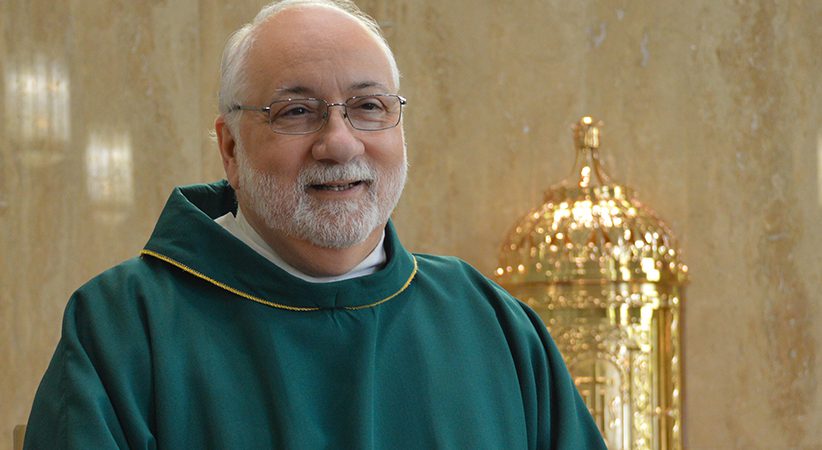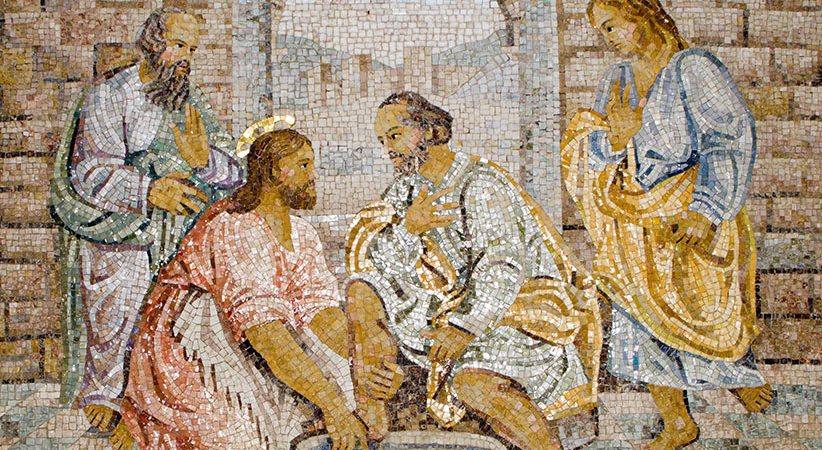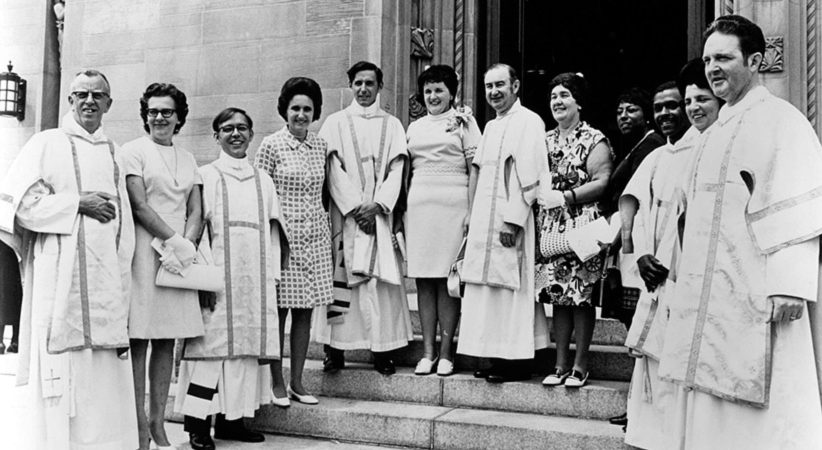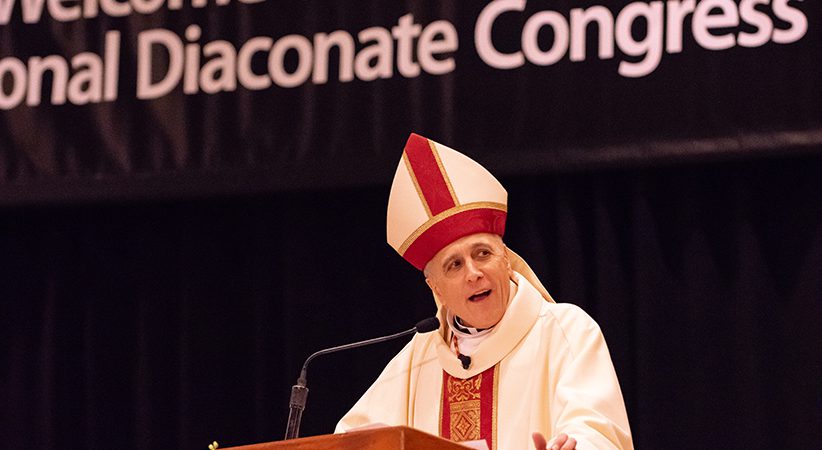The Joy of Baptisms
The sacrament goes to the heart of the deacon’s vocation
Deacon Greg Kandra Comments Off on The Joy of Baptisms
Like a lot of clergy, I have a small green hardcover book I use regularly. It’s an ordination gift, Rite of Baptism for Children. Inside the back cover is a name and a date:
Margaret Flanagan
First Baby Baptized
July 1, 2007
Barely a month goes by that I don’t glance at that name, whisper a prayer and smile. I don’t know what became of young Margaret or her family, but our lives are forever entwined by that moment when water and a few nervously spoken words changed everything.
A lot has happened since that July day in 2007, barely a month after my ordination. But I remember vividly that afternoon: the nervous catch in my throat, the way I scrupulously followed every line and rubric — practicing it several times at home before I did it in church — and feeling dampness on my cheek that wasn’t caused by the splash of water from the font. Was there something in my eye? No. It was me. I couldn’t help but sniff back the tears.
Was I really doing this? Incredibly, yes.
I’ve done it hundreds of times since. But that day was the beginning of a unique and enduring love affair.
Put simply, I love baptisms. The water. The prayers. The families. The squirming, squealing, wailing signs of life. The bright, sweet smell of chrism lingers for hours on my thumb.
I know I’m not the only deacon who feels this way; I’ve heard it from others, always with a mixture of embarrassment and wonder. How could something so simple and fundamental have such a hold on us? After all, it is something we do so often — and, let’s face it, it can be done by virtually anyone, if the need arises. It’s so commonplace we can almost take it for granted.
We shouldn’t.
There is something inescapably beautiful and humbling about being able to celebrate this sacrament, of being the “ordinary minister” of it. It goes to the heart of the ritual and, I think, our very vocation.
Christian Adventure
What is it that is so captivating? Let me suggest three ideas:
First, it places us at the very beginning of the Christian adventure. Deacon Tim O’Donnell, in his book “The Deacon: Icon of Christ the Servant” (Paulist, $29.95), has eloquently described the deacon as a “minister of the threshold” — reaching out to others to invite them to share in the Christian life. I think there is no more astonishing or wondrous threshold than the one filled with water at the baptismal font! This is the great entryway for all of us, and what a joy it is to be there making it all possible at the very instant a young life becomes a Catholic Christian, a sibling of Jesus Christ.
More than a few times, I’ve stepped back from the font, dried the child’s head and wondered, What happens next? Where will this young disciple be headed? How will they love God and their neighbor? How will they change the world? Anything is possible. Everything is possible. I feel like a new parent. The words of the great hymn “Praise to the Lord” echo in my heart: “Ponder anew what the Almighty can do.”
Baptism is an occasion for pondering — and then taking a deep breath. God has something in store. An adventure is beginning.
The Church at Its Best
Second, baptism often shows us the Church at its best. It’s all here: history, tradition, ritual, prayer, symbolism, praise and thanksgiving. I know that’s lost on some people. Some families are just going through the motions to please a grandparent or do something expected. Others use it as an excuse to throw a big party and unpack a treasured gown from the attic, the one a great-grandparent wore at their baptism. They want to signify the continuation of the circle of life (cue “The Lion King” soundtrack). Some mothers and fathers show up in jeans and yoga pants. Once, I had to ask a godfather to take off his baseball cap.
But then there are the others.

There are the parents who dress up in their Sunday best. They buy little rosaries to be blessed. They see this moment for what it is: something profound and beautiful, sacred and special. Sometimes, the mother will wear a wrist corsage and the father will sport a boutonniere. And it’s not just to create an event. Many of these families know that this moment matters and shouldn’t be treated as just another outing.
I remember the Polish parents who, after their baby was anointed with chrism, dabbed the oil onto a neatly pressed white cloth, closed their eyes, inhaled the fragrance and smiled. They told me later it was a tradition to preserve the cloth with the chrism as a keepsake.
I remember the young couple who stood quietly while I pronounced, at the conclusion, the blessing on the mother, who cradled her baby in one arm and then used her free hand to gently take her husband’s hand and hold it tightly for the rest of the ritual.
I remember the young boy, a toddler, who screamed his lungs out through the entire baptism and squirmed to get away from me and wanted nothing to do with any of it. After his parents struggled to get him over the font, the water splashed over his head and I whispered the words, “I baptize you …” and he became suddenly, unexpectedly, beautifully still. He was quiet. Something just took. A miracle? Grace? Exhaustion? Maybe all of the above.
Baptism is also an occasion when the Church not only ministers to the People of God but when the People of God minister to one another. It is a public profession of faith, hope and love — when believers make an effort to share that with others, particularly the one being baptized.
Baptism is, almost always, a time of great joy. Parents, godparents, grandparents, friends and relatives see this as a moment of passage, a singular occasion of promise and hope. It’s fairly straightforward. And it can help catechize, showing non-Catholics and unbelievers a foundational sacrament. It offers to any witnesses a window into our faith.
Love Letter
Finally, it is, as someone once described it, “a love letter to the future.” A baptism does more than celebrate something here and now, with prayers and water and a family party after; it is nothing less than an investment in the future of the Church. It is a group of people coming together to say, “I believe” — and they profess that they want their children, the next generation, to carry that belief forward. As the ritual puts it, in one of the great declarations in any liturgy anywhere: “This is our faith. This is the faith of the Church. We are proud to profess it in Christ Jesus, our Lord.”
When I preach at baptisms, I often tell the story of when I visited the baptism site of Jesus in Jordan several years ago. It is now a World Heritage Site, and a growing tourist destination. I recount how people became Christian there in the early centuries of the Faith. They walked to the river, were baptized and were led back to a nearby church, where they were handed a stone. Using the stone, they scratched on the foundation of the building a simple cross, their way of signifying that they had been there and that they were leaving that place as followers of Christ. “They left their mark on the Church,” I say, “and we pray these children will leave their mark on it, too.”
Legacy to Carry Forward
The Sacrament of Baptism reminds all of us that we have a legacy we are carrying forward, a legacy that stretches back 20 centuries and that endows the newly baptized with something wonderful and mysterious.
It gives forth grace. Amazing grace.
And how wonderful and mysterious and amazing that we, as deacons, can be a part of that!
We join a long line of baptizers through the centuries who have stood at the threshold of the font, holding a shell and a towel and offering a blessing of welcome.
It reminds me that we are part of a vocation that embraces great beginnings which announces Good News and shares in Christ’s own ministry of service, healing and hope. Baptism does all of that. Even better: It endures. It marks the baptized forever.
I think it marks us who do it, too.
It has surely left its mark on me.
DEACON GREG KANDRA is the creator of The Deacon’s Bench blog and is the multimedia editor for Catholic Near East Welfare Association (CNEWA).
……………………………………………………………………………………………………………………………………………………………………………
The Sacrament of Baptism
“Holy Baptism is the basis of the whole Christian life, the gateway to life in the Spirit (vitae spiritualis ianua), and the door which gives access to the other sacraments. Through Baptism we are freed from sin and reborn as sons of God; we become members of Christ, are incorporated into the Church and made sharers in her mission: ‘Baptism is the sacrament of regeneration through water in the word.’” — Catechism of the Catholic Church, No. 1213
…………………………………………………………………………………………………………………………………………………………………………….





